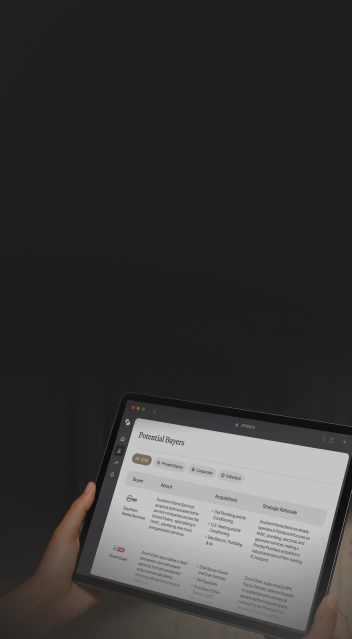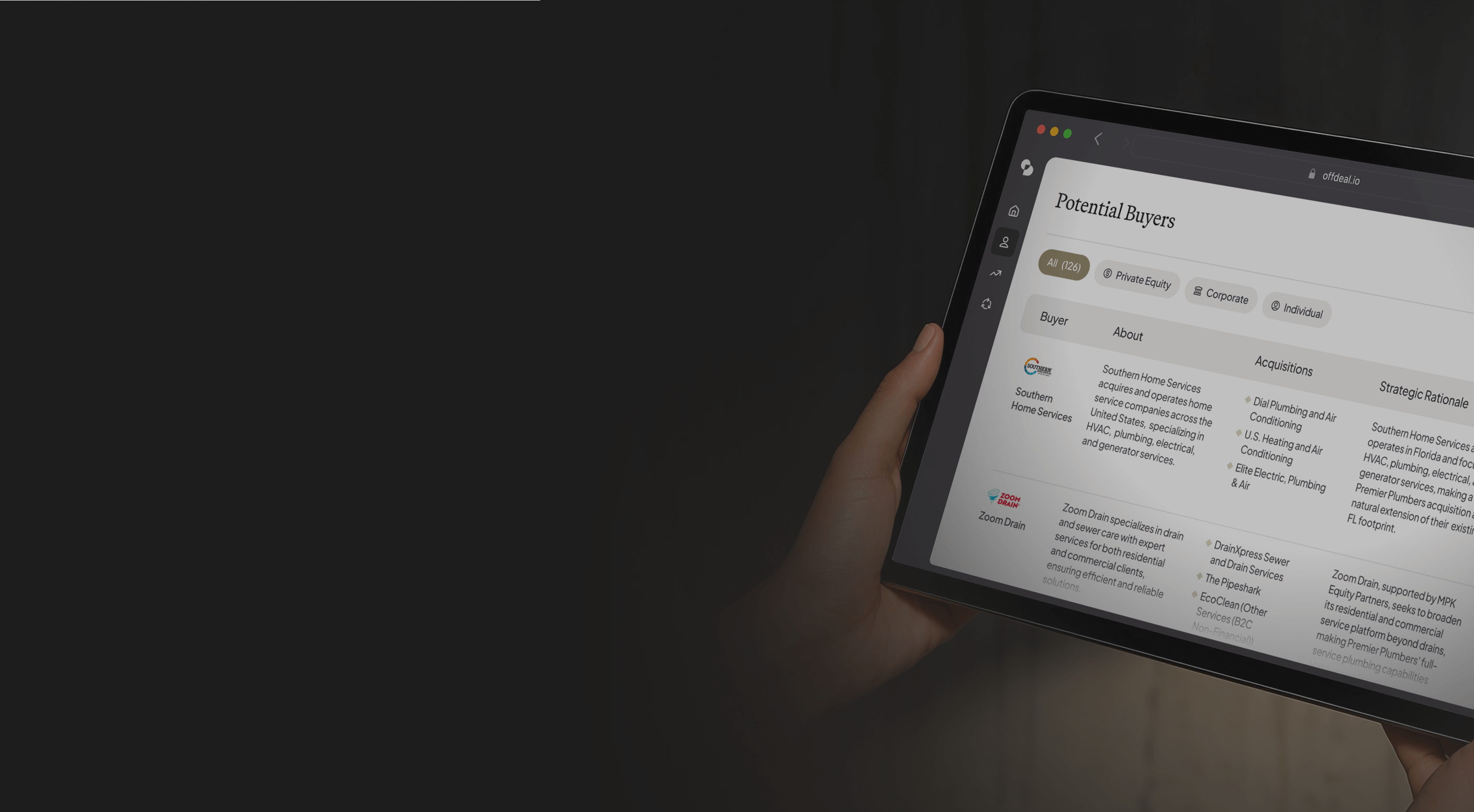Article
March 4, 2025
How to Maximize Valuation for a Roofing Business
Selling your roofing business? Discover proven strategies to boost valuation, attract serious buyers, and ensure you achieve top dollar

Table of Contents
If you’re considering selling your roofing business, understanding how to maximize its valuation is crucial. The roofing industry can vary widely, with companies providing anything from routine residential repairs to large, multifaceted commercial installations. Each segment has a specific risk and reward profile, directly influencing your business’s overall value when it’s time to sell.
Potential buyers—whether they are individual investors, competitors looking to expand market share, or private equity groups—focus heavily on risk reduction and predictable earnings. To get top dollar for your roofing business, you need to systematically enhance stability, document growth potential, and clearly showcase your business’s competitive advantages.
In this guide, you'll learn exactly what determines a roofing company's valuation, including:
The impact of service and market mix (residential vs. commercial, repair vs. replacement)
How recurring maintenance revenue stabilizes earnings and boosts multiples
Why customer diversification minimizes business risks and increases value
Actionable strategies to improve financial records and business processes before sale
Real-world examples and strategies to position your company for an optimal sale price
By understanding exactly what drives value and taking proactive steps, you’ll increase your likelihood of fetching a premium valuation.
Why Roofing Businesses Are Unique
Roofing companies enjoy robust industry demand because they provide an essential service that homeowners and business owners cannot postpone indefinitely. However, within the roofing industry, valuations fluctuate greatly based upon the stability of revenue streams, customer diversification, and type of projects you handle.
Consider two hypothetical roofing companies:
| Roofing Company | Primary Services | Revenue Stability | Typical Valuation Multiple |
|---|---|---|---|
| Company A | Residential roof repairs & maintenance | High due to recurring revenue | 4-6x SDE |
| Company B | Large commercial roof replacement projects | Low; dependent on construction activity | 2-4x SDE |
As shown, Company A typically attracts a far higher valuation due to predictable customer revenue, whereas Company B faces lower multiples because its projects are more volatile and economically sensitive.
Roofing Service Mix and Its Impact on Valuation
Roof Repairs & Maintenance (High Valuation Multiple)
Pros: Steady workflow, predictable income, lower risk.
Cons: Requires strong customer service and marketing to maintain consistent volume.
Valuation Impact: Higher multiples (4-6x SDE) because of stable recurring revenue streams.
Roof Replacement & Large Projects (Moderate to Low Valuation Multiple)
Pros: Higher average project values, potential to generate substantial one-off revenues.
Cons: Revenue is heavily reliant on economic factors, weather patterns, and new construction cycles.
Valuation Impact: Moderate to lower valuation multiples (2-4x SDE), depending on economic stability and performance history.
| Roofing Service Mix | Revenue Stability | Valuation Multiple (SDE) |
|---|---|---|
| Primarily Repairs & Maintenance | High | 4-6x SDE |
| Balanced Mix (Maintenance & Replacement) | Moderate | 3-5x SDE |
| Primarily Large Project Replacement & Installation | Low | 2-4x SDE |
Key Takeaway:
Focusing your roofing business to include significant recurring maintenance revenue can substantially boost its overall valuation.
End Markets Served: Residential vs. Commercial
Residential Roofing
Smaller ticket sizes but often higher profit margins per job
Revenues driven by strong reputation in local communities (reviews, referrals)
High stability if customer base is broad and frequently maintained
Valuation Impact: Can enhance valuation significantly when combined with recurring maintenance agreements or strong local branding
Multifamily & Apartment Complexes
Regular roofing maintenance contracts and bi-annual checks
Predictable revenue flows and high repeat business through property management agreements
Valuation Impact: Attractive to buyers, as recurring business reduces risk and uncertainty
Commercial & Industrial Roofing
Typically higher revenue per project; complex jobs with higher capital costs
Revenue can be stable when multi-year maintenance contracts are secured; riskier otherwise
Exposure to cyclical new construction markets can reduce valuations or create volatility
Valuation Impact: Strong if diversified and secured through repeat maintenance agreements; lower if reliant solely on large one-off installation projects
Service Mix & Market Segment: Lowest to Highest Risk
When considering selling your roofing business, it’s helpful to understand how buyers perceive the risk of the various services and markets you offer:
From lowest risk to highest, here’s how roofing services and segments stack up:
Commercial Roofing Maintenance (Lowest Risk): Multi-year, predictable contracts
Multifamily & Residential Roofing Maintenance: Recurring small jobs with frequent contacts
Commercial Roofing New Installations: Project based, economically sensitive
Residential Roofing Replacements & New Construction (Highest Risk): Smaller market size per project, cyclical demand based on local economy
Real-World Valuation Example: Two Roofing Businesses
Look at two hypothetical roofing businesses with identical EBITDA ($1 million), yet drastically different valuations:
| Metric | Roofing Company A | Roofing Company B |
|---|---|---|
| Annual Revenue | $5 Million | $7 Million |
| EBITDA | $1 Million | $1 Million |
| Services & Market Dynamics | - 70% recurring residential maintenance - Diversified customer base | - 100% large commercial installations - 3 clients represent 75% of revenue |
| Valuation Multiple | 5.5x | 3x |
| Total Business Valuation | $5.5 Million | $3 Million |
Why Such a Difference?
Buyers prefer Company A due to steady recurring residential revenue and low customer concentration risks. Company B’s reliance on a few large commercial projects presents far more volatility.
Tips for Increasing Your Roofing Business's Valuation
Foster Recurring Revenue Opportunities
Build long-term residential service agreements or routine roofing maintenance packages.
Prioritize customer retention programs to amplify predictable earnings.
Diversify Your Customer Base
Limit dependence on one customer or large general contractors.
Target new segments (apartments, HOAs, municipal contracts) for revenue stability.
Demonstrate Clear Growth Potential
Showcase your plan for geographic expansion or new service lines (e.g., solar roof installations, energy-efficient roofing options).
Buyers value clearly articulated strategies for future growth.
Documented Processes & Reducing Owner Dependence
Develop Standard Operating Procedures (SOPs), training manuals, and employee onboarding processes.
Empower leadership teams below the owner to manage daily operations independently.
Maintain Clear, Organized Financial Records & Reporting
Keep personal and business expenses entirely separate.
Clearly itemize all revenue streams, job profitability, and overhead expenses on financial statements.
Clean financial records reassure buyers and expedite due diligence, enabling better offers.
Who Buys Roofing Businesses & Why It Matters
Individual Investors & Entrepreneurs:
Seek stable, turnkey businesses with predictable cash flow. Clean financial documentation and growth upside are essential.
Strategic Buyers (Competing Roofing Firms or Larger Home Service Companies):
Look for synergistic services, geographical expansions, customer networks, equipment, and skilled teams.
Private Equity Groups:
Prioritize recurring revenue streams, significant EBITDA margins, and clear potential for scalability, typically paying attractive multiples for the right businesses.
Next Steps: Ready to Sell Your Roofing Business?
As you prepare to sell your roofing operation, identifying your business’s unique strengths and weaknesses is crucial. To summarize, your valuation depends significantly on three key factors:
Stability and quantity of recurring revenue
Customer diversity and contractual risk profile
Clear processes and low owner dependency
If you’re ready to take the next step in selling or simply want to understand your roofing company’s value better:
Schedule a complimentary, confidential valuation consultation.
Receive personalized recommendations to optimize your roofing business valuation.
Identify exactly what strategic buyers look for when acquiring roofing businesses.
Whether you're actively pursuing a potential buyer or simply want to benchmark your progress, addressing these valuation factors positions your roofing business for maximum profitability when the right opportunity arises.

Preview Buyers for Free
Try our buyer match tool to receive a personalized list of active buyers in your industry

